Emergence of Nontrivial Spin Textures in Frustrated Van Der Waals Ferromagnets
Abstract
:1. Introduction
2. Theoretical and Computational Methods
2.1. Frustrated Van Der Waals Ferromagnets
2.2. Skyrmion Formation in the Spin Hall Regime
2.3. Spin Memory Loss at Interfaces
3. Results and Discussion
3.1. Distribution of Magnetic Moments at Ground State
3.2. Interface Spin Transparency
3.3. Skyrmion Induced Transition from Soft to Hard Ferromagnetic State
3.4. Skyrmion Stabilization in External Fields
3.5. Electrical Write-In and Read-Out Operation Cycle
4. Conclusions
Funding
Institutional Review Board Statement
Informed Consent Statement
Data Availability Statement
Acknowledgments
Conflicts of Interest
References
- Kandel, Y.P.; Qiao, H.; Fallahi, S.; Gardner, G.C.; Manfra, M.J.; Nichol, J.M. Coherent spin-state transfer via Heisenberg exchange. Nature 2019, 573, 553–557. [Google Scholar] [CrossRef] [Green Version]
- Fernández-Pacheco, A.; Vedmedenko, E.; Ummelen, F.; Mansell, R.; Petit, D.; Cowburn, R.P. Symmetry-breaking interlayer Dzyaloshinskii–Moriya interactions in synthetic antiferromagnets. Nat. Mater. 2019, 18, 679–684. [Google Scholar] [CrossRef] [PubMed]
- Kazemi, M.; Bocko, M.F. Design rules for scalability in spin-orbit electronics. Sci. Rep. 2019, 13732. [Google Scholar] [CrossRef] [PubMed] [Green Version]
- Coey, J.M.D. Magnetism in d0 oxides. Nat. Mater. 2019, 18, 652–656. [Google Scholar] [CrossRef] [PubMed]
- Dettwiler, F.; Fu, J.; Mack, S.; Weigele, P.J.; Egues, J.C.; Awschalom, D.D.; Zumbühl, D.M. Stretchable Persistent Spin Helices in GaAs Quantum Wells. Phys. Rev. X 2017, 7, 031010. [Google Scholar] [CrossRef] [Green Version]
- Koralek, J.D.; Weber, C.P.; Orenstein, J.; Bernevig, B.A.; Zhang, S.-C.; Mack, S.; Awschalom, D.D. Emergence of the persistent spin helix in semiconductor quantum wells. Nature 2009, 458, 610–613. [Google Scholar] [CrossRef] [Green Version]
- Kohda, M.; Lechner, V.; Kunihashi, Y.; Dollinger, T.; Olbrich, P.; Schönhuber, C.; Caspers, I.; Bel’kov, V.V.; Golub, L.E.; Weiss, D.; et al. Gate-controlled persistent spin helix state in (In,Ga)As quantum wells. Phys. Rev. B 2012, 86, 081306. [Google Scholar] [CrossRef] [Green Version]
- Everschor-Sitte, K.; Masell, J.; Reeve, R.M.; Kläui, M. Perspective: Magnetic skyrmions—Overview of recent progress in an active research field. J. Appl. Phys. 2018, 124, 240901. [Google Scholar] [CrossRef] [Green Version]
- Zhou, Y. Magnetic skyrmions: Intriguing physics and new spintronic device concepts. Natl. Sci. Rev. 2019, 6, 210–212. [Google Scholar] [CrossRef] [Green Version]
- Fert, A.; Reyren, N.; Cros, V. Magnetic skyrmions: Advances in physics and potential applications. Nat. Rev. Mater. 2017, 2, 17031. [Google Scholar] [CrossRef]
- Finocchio, G.; Büttner, F.; Tomasello, R.; Carpentieri, M.; Kläui, M. Magnetic skyrmions: From fundamental to applications. J. Phys. D Appl. Phys. 2016, 49, 423001. [Google Scholar] [CrossRef]
- Tao, L.L.; Tsymbal, E.Y. Persistent spin texture enforced by symmetry. Nat. Commun. 2018, 9, 2763. [Google Scholar] [CrossRef] [PubMed] [Green Version]
- Wong, P.K.J.; Zhang, W.; Bussolotti, F.; Yin, X.; Herng, T.S.; Zhang, L.; Huang, Y.L.; Vinai, G.; Krishnamurthi, S.; Bukhvalov, D.W.; et al. Evidence of Spin Frustration in a Vanadium Diselenide Monolayer Magnet. Adv. Mater. 2019, 31, e1901185. [Google Scholar] [CrossRef] [Green Version]
- Jiang, W.; Upadhyaya, P.; Zhang, W.; Yu, G.; Jungfleisch, M.B.; Fradin, F.Y.; Pearson, J.E.; Tserkovnyak, Y.; Wang, K.L.; Heinonen, O.; et al. Magnetism. Blowing magnetic skyrmion bubbles. Science 2015, 349, 6245. [Google Scholar] [CrossRef] [PubMed] [Green Version]
- Das, S.; Tang, Y.L.; Hong, Z.; Gonçalves, M.A.P.; McCarter, M.R.; Klewe, C.; Nguyen, K.X.; Gómez-Ortiz, F.; Shafer, P.; Arenholz, E.; et al. Observation of room-temperature polar skyrmions. Nature 2019, 568, 368–372. [Google Scholar] [CrossRef] [Green Version]
- Yang, J.-H.; Xiang, H. Van der Waals engineering of magnetism. Nat. Mater. 2019, 18, 1273–1274. [Google Scholar] [CrossRef]
- Chappert, C.; Kim, J.-V. Electronics free of charge. Nat. Phys. 2008, 4, 837–838. [Google Scholar] [CrossRef]
- Liu, L.; Pai, C.-F.; Li, Y.; Tseng, H.W.; Ralph, D.C.; Buhrman, R.A. Spin-Torque Switching with the Giant Spin Hall Effect of Tantalum. Science 2012, 336, 555–558. [Google Scholar] [CrossRef] [Green Version]
- Sinova, J.; Valenzuela, S.O.; Wunderlich, J.; Back, C.H.; Jungwirth, T. Spin Hall effects. Rev. Mod. Phys. 2015, 87, 1213–1259. [Google Scholar] [CrossRef]
- Rojas Sánchez, J.C.; Vila, L.; Desfonds, G.; Gambarelli, S.; Attané, J.P.; De Teresa, J.M.; Magén, C.; Fert, A. Spin-to-charge conversion using Rashba coupling at the interface between non-magnetic materials. Nat. Commun. 2013, 4, 2944. [Google Scholar] [CrossRef] [Green Version]
- Bychkov, Y.A.; Rashba, É.I. Properties of a 2D electron gas with lifted spectral degeneracy. JETP Lett. 1984, 39, 78–81. Available online: http://jetpletters.ru/ps/1264/article_19121.shtml (accessed on 14 January 2021).
- Tserkovnyak, Y.; Brataas, A.; Bauer, G.E.W. Enhanced Gilbert Damping in Thin Ferromagnetic Films. Phys. Rev. Lett. 2002, 88, 117601. [Google Scholar] [CrossRef] [Green Version]
- Tserkovnyak, Y.; Brataas, A.; Bauer, G.E.W. Spin pumping and magnetization dynamics in metallic multilayers. Phys. Rev. B 2002, 66, 224403. [Google Scholar] [CrossRef] [Green Version]
- Fukuma, Y.; Wang, L.; Idzuchi, H.; Takahashi, S.; Maekawa, S.; Otani, Y. Giant enhancement of spin accumulation and long-distance spin precession in metallic lateral spin valves. Nat. Mater. 2011, 10, 527–531. [Google Scholar] [CrossRef] [Green Version]
- Demidov, V.E.; Urazhdin, S.; Liu, R.; Divinskiy, B.; Telegin, A.; Demokritov, S.O. Excitation of coherent propagating spin waves by pure spin currents. Nat. Commun. 2016, 7, 10446. [Google Scholar] [CrossRef] [PubMed]
- Hoffmann, A.; Bader, S.D. Opportunities at the Frontiers of Spintronics. Phys. Rev. Appl. 2015, 4, 047001. [Google Scholar] [CrossRef] [Green Version]
- Fukami, S.; Anekawa, T.; Zhang, C.; Ohno, H. A spin–orbit torque switching scheme with collinear magnetic easy axis and current configuration. Nat. Nanotechnol. 2016, 11, 621. [Google Scholar] [CrossRef]
- Shi, S.; Ou, Y.; Aradhya, S.V.; Ralph, D.C.; Buhrman, R.A. Fast Low-Current Spin-Orbit-Torque Switching of Magnetic Tunnel Junctions through Atomic Modifications of the Free-Layer Interfaces. Phys. Rev. Appl. 2018, 9, 011002. [Google Scholar] [CrossRef] [Green Version]
- Demidov, V.E.; Urazhdin, S.; Ulrichs, H.; Tiberkevich, V.; Slavin, A.; Baither, D.; Schmitz, G.; Demokritov, S.O. Magnetic nano-oscillator driven by pure spin current. Nat. Mater. 2012, 11, 1028. [Google Scholar] [CrossRef]
- Schick, D.; Deisenhofer, M.; Rózsa, L.; Nowak, U. Skyrmions as quasiparticles: Free energy and entropy. Phys. Rev. B 2021, 103, 214417. [Google Scholar] [CrossRef]
- Song, K.M.; Jeong, J.-S.; Pan, B.; Zhang, X.; Xia, J.; Cha, S.; Park, T.-E.; Kim, K.; Finizio, S.; Raabe, J.; et al. Skyrmion-based artificial synapses for neuromorphic computing. Nat. Electron. 2020, 3, 148–155. [Google Scholar] [CrossRef] [Green Version]
- Kurumaji, T.; Nakajima, T.; Hirschberger, M.; Kikkawa, A.; Yamasaki, Y.; Sagayama, H.; Nakao, H.; Taguchi, Y.; Arima, T.; Tokura, Y. Skyrmion lattice with a giant topological Hall effect in a frustrated triangular-lattice magnet. Science 2019, 365, 914–918. [Google Scholar] [CrossRef] [PubMed] [Green Version]
- Ukpong, A.M. Axial field induced spin response in Fe/hBN-based tunnel junctions. Phys. Rev. B 2019, 100, 035424. [Google Scholar] [CrossRef]
- Nagaosa, N.; Tokura, Y. Topological properties and dynamics of magnetic skyrmions. Nat. Nanotech. 2013, 8, 899. [Google Scholar] [CrossRef]
- Hoffmann, M.; Zimmermann, B.; Müller, G.P.; Schürhoff, D.; Kiselev, N.S.; Melcher, C.; Blügel, S. Antiskyrmions stabilized at interfaces by anisotropic Dzyaloshinskii-Moriya interactions. Nat. Commun. 2017, 8, 308. [Google Scholar] [CrossRef]
- Ukpong, A.M. Tunable magnetotransport in Fe/hBN/graphene/hBN/Pt(Fe) epitaxial multilayers. J. Phys. D Appl. Phys. 2018, 51, 095302. [Google Scholar] [CrossRef]
- Ukpong, A.M. Ab initio studies of coherent spin transport in Fe-hBN/graphene van der Waals multilayers. J. Phys. Condens. Matter 2017, 29, 285302. [Google Scholar] [CrossRef] [PubMed]
- Larsen, A.H.; Mortensen, J.J.; Blomqvist, J.; Castelli, I.E.; Christensen, R.; Dułak, M.; Friis, J.; Groves, M.N.; Hammer, B.; Hargus, C.; et al. The atomic simulation environment—a Python library for working with atoms. J. Phys. Condens. Matter 2017, 29, 273002. [Google Scholar] [CrossRef] [PubMed] [Green Version]
- Li, H.; Ruan, S.; Zeng, Y.-J. Intrinsic Van Der Waals Magnetic Materials from Bulk to the 2D Limit: New Frontiers of Spintronics. Adv. Mater. 2019, 31, 1900065. [Google Scholar] [CrossRef] [PubMed]
- Dolui, K.; Petrović, M.D.; Zollner, K.; Plecháč, P.; Fabian, J.; Nikolić, B.K. Proximity Spin-Orbit Torque on a Two-Dimensional Magnet within van der Waals Heterostructure: Current-Driven Antiferromagnet-to-Ferromagnet Reversible Nonequilibrium Phase Transition in Bilayer CrI3. Nano Lett. 2020, 20, 2288–2295. [Google Scholar] [CrossRef]
- Lee, K.; Murray, E.D.; Kong, L.; Lundqvist, B.I.; Langreth, D.C. Higher-accuracy van der Waals density functional. Phys. Rev. B 2010, 82, 081101. [Google Scholar] [CrossRef] [Green Version]
- Giannozzi, P.; Baroni, S.; Bonini, N.; Calandra, M.; Car, R.; Cavazzoni, C.; Ceresoli, D.; Chiarotti, G.L.; Cococcioni, M.; Dabo, I.; et al. QUANTUM ESPRESSO: A modular and open-source software project for quantum simulations of materials. J. Phys. Condens. Matter 2009, 21, 395502. [Google Scholar] [CrossRef]
- Giannozzi, P.; Andreussi, O.; Brumme, T.; Bunau, O.; Buongiorno Nardelli, M.; Calandra, M.; Car, R.; Cavazzoni, C.; Ceresoli, D.; Cococcioni, M.; et al. Advanced capabilities for materials modelling with Quantum ESPRESSO. J. Phys. Condens. Matter 2017, 29, 465901. [Google Scholar] [CrossRef] [PubMed] [Green Version]
- Kresse, G.; Joubert, D. From ultrasoft pseudopotentials to the projector augmented-wave method. Phys. Rev. B 2009, 59, 1758. [Google Scholar] [CrossRef]
- Monkhorst, H.J.; Pack, J.D. Special points for Brillouin-zone integrations. Phys. Rev. B 1976, 13, 5188. [Google Scholar] [CrossRef]
- Marzari, N.; Vanderbilt, D.; De Vita, A.; Payne, M.C. Thermal Contraction and Disordering of the Al(110) Surface. Phys. Rev. Lett. 1999, 82, 3296. [Google Scholar] [CrossRef] [Green Version]
- Hadley, K.R.; McCabe, C. Coarse-Grained Molecular Models of Water: A Review. Mol. Simul. 2012, 38, 671–681. [Google Scholar] [CrossRef]
- Evans, R.F.L.; Fan, W.J.; Chureemart, P.; Ostler, T.A.; Ellis, M.O.A.; Chantrel, R.W. Atomistic spin model simulations of magnetic nanomaterials. J. Phys. Condens. Matter 2014, 26, 103202. [Google Scholar] [CrossRef]
- Landau, L.; Lifshitz, E. On the theory of the dispersion of magnetic permeability in ferromagnetic bodies. Phys. Z. Sowjet. 1935, 8, 153. Available online: http://cds.cern.ch/record/437299 (accessed on 22 January 2021).
- Gilbert, T.L. A phenomenological theory of damping in ferromagnetic materials. IEEE Trans. Magn. 2004, 40, 3443. [Google Scholar] [CrossRef]
- Zhu, L.; Ralph, D.C.; Buhrman, R.A. Effective Spin-Mixing Conductance of Heavy-Metal–Ferromagnet Interfaces. Phys. Rev. Lett. 2019, 123, 057203. [Google Scholar] [CrossRef] [Green Version]
- Müller, G.P.; Hoffmann, M.; Dißelkamp, C.; Schürhoff, D.; Mavros, S.; Sallermann, M.; Kiselev, N.S.; Jónsson, H.; Blügel, S. Spirit: Multifunctional framework for atomistic spin simulations. Phys. Rev. B 2019, 99, 224414. [Google Scholar] [CrossRef] [Green Version]
- Conca, A.; Keller, S.; Mihalceanu, L.; Kehagias, T.; Dimitrakopulos, G.P.; Hillebrands, B.; Papaioannou, E.T. Study of fully epitaxial Fe/Pt bilayers for spin pumping by ferromagnetic resonance spectroscopy. Phys. Rev. B 2016, 93, 134405. [Google Scholar] [CrossRef]
- Weisheit, M.; Fähler, S.; Marty, A.; Souche, Y.; Poinsignon, C.; Givord, D. Electric Field-Induced Modification of Magnetism in Thin-Film Ferromagnets. Science 2007, 315, 349–351. [Google Scholar] [CrossRef] [PubMed]
- Li, Y.; Zhang, W.; Li, N.; Sun, R.; Tang, J.; Gong, Z.Z.; Li, Y.; Yang, X.; Xie, Z.K.; Gul, Q.; et al. Optical determination of spin diffusion length and interfacial spin mixing conductance in epitaxial Pd/Fe bilayers. J. Phys. Condens. Matter 2019, 31, 305802. [Google Scholar] [CrossRef] [PubMed]
- Han, X.M.; Ma, J.H.; Wang, Z.; Yao, Y.L.; Zuo, Y.L.; Xi, L.; Xue, D.S. Tunable in-plane uniaxial anisotropy and the magnetization reversal mechanism of patterned high-frequency soft magnetic FeTa strips. J. Phys. D Appl. Phys. 2013, 46, 485004. [Google Scholar] [CrossRef]
- Chen, X.; Ma, Y.G.; Ong, C.K. Magnetic anisotropy, and resonance frequency of patterned soft magnetic strips. J. Appl. Phys. 2008, 104, 013921. [Google Scholar] [CrossRef]
- Hönemann, A.; Herschbach, C.; Fedorov, D.V.; Gradhand, M.; Mertig, I. Spin and charge currents induced by the spin Hall and anomalous Hall effects upon crossing ferromagnetic/nonmagnetic interfaces. Phys. Rev. B 2019, 99, 024420. [Google Scholar] [CrossRef] [Green Version]
- Dolui, K.; Nikolic, B.K. Spin-memory loss due to spin-orbit coupling at ferromagnet/heavy-metal interfaces: Ab initio spin-density matrix approach. Phys. Rev. B 2017, 96, 220403. [Google Scholar] [CrossRef] [Green Version]
- Amin, V.P.; Li, J.; Stiles, M.D.; Haney, P.M. Intrinsic spin currents in ferromagnets. Phys. Rev. B 2019, 99, 220405. [Google Scholar] [CrossRef] [Green Version]
- Pfleiderer, C.; Rosch, A. Single skyrmions spotted. Nature 2010, 465, 880–881. [Google Scholar] [CrossRef]
- Schulz, T.; Ritz, R.; Bauer, A.; Halder, M.; Wagner, M.; Franz, C.; Pfleiderer, C.; Everschor, K.; Garst, M.; Rosch, A. Emergent electrodynamics of skyrmions in a chiral magnet. Nat. Phys. 2012, 8, 301–304. [Google Scholar] [CrossRef] [Green Version]
- Chen, T.; Byrnes, T. Skyrmion quantum spin Hall effect. Phys. Rev. B 2019, 99, 184427. [Google Scholar] [CrossRef] [Green Version]
- Guo, G.Y.; Murakami, S.; Chen, T.-W.; Nagaosa, N. Intrinsic Spin Hall Effect in Platinum: First-Principles Calculations. Phys. Rev. Lett. 2008, 100, 096401. [Google Scholar] [CrossRef] [PubMed] [Green Version]
- Nardelli, M.B.; Cerasoli, F.T.; Costa, M.; Curtarolo, S.; Gennaro, R.D.; Fornari, M.; Liyanage, L.; Supka, A.R.; Wang, H. PAOFLOW: A utility to construct and operate on ab initio Hamiltonians from the projections of electronic wavefunctions on atomic orbital bases, including characterization of topological materials. Comput. Mater. Sci. 2018, 43, 462–472. [Google Scholar] [CrossRef]
- Guo, G.Y. Ab initio calculation of intrinsic spin Hall conductivity of Pd and Au. J. Appl. Phys. 2009, 105, 07C701. [Google Scholar] [CrossRef] [Green Version]
- Kimura, T.; Otani, Y.; Sato, T.; Takahashi, S.; Maekawa, S. Room-Temperature Reversible Spin Hall Effect. Phys. Rev. Lett. 2007, 98, 156601. [Google Scholar] [CrossRef] [Green Version]
- Akamine, H.; Okumura, S.; Farjami, S.; Murakami, Y.; Nishida, M. Imaging of surface spin textures on bulk crystals by scanning electron microscopy. Sci. Rep. 2016, 6, 37265. [Google Scholar] [CrossRef] [PubMed] [Green Version]
- Blundell, S. Magnetism in Condensed Matter; Oxford University Press: Oxford, UK, 2001; p. 147. [Google Scholar]
- Jiang, W.; Chen, G.; Liu, K.; Zang, J.; Te Velthuis, S.G.E.; Hoffmann, A. Skyrmions in magnetic multilayers. Phys. Rep. 2017, 704, 1–49. [Google Scholar] [CrossRef] [Green Version]
- Kim, B.S. Skyrmions and Hall Transport. J. Phys. Condens. Matter 2019, 31, 383001. [Google Scholar] [CrossRef] [PubMed] [Green Version]
- Chen, G.; Mascaraque, A.; Jia, H.; Zimmermann, B.; Robertson, M.; Conte, R.L.; Hoffmann, M.; Barrio, M.A.G.; Ding, H.; Wiesendanger, R.; et al. Large Dzyaloshinskii-Moriya interaction induced by chemisorbed oxygen on a ferromagnet surface. Sci. Adv. 2020, 6, eaba4924. [Google Scholar] [CrossRef]
- Udalov, O.G.; Beloborodov, I.S.; Sapozhnikov, M.V. Magnetic skyrmions and bimerons in films with anisotropic interfacial Dzyaloshinskii-Moriya interaction. Phys. Rev. B 2021, 103, 174416. [Google Scholar] [CrossRef]
- Borisov, V.; Kvashnin, Y.O.; Ntallis, N.; Thonig, D.; Thunström, P.; Pereiro, M.; Bergman, A.; Sjöqvist, E.; Delin, A.; Nordström, L.; et al. Heisenberg and anisotropic exchange interactions in magnetic materials with correlated electronic structure and significant spin-orbit coupling. Phys. Rev. B 2021, 103, 174422. [Google Scholar] [CrossRef]
- Bruzzone, S.; Logoteta, D.; Fiori, G.; Iannaccone, G. Vertical transport in graphene-hexagonal boron nitride heterostructure devices. Sci. Rep. 2015, 5, 4519. [Google Scholar] [CrossRef] [Green Version]
- Murakami, S.; Nagaosa, N.; Zhang, S.-C. Dissipationless Quantum Spin Current at Room Temperature. Science 2003, 301, 1348. [Google Scholar] [CrossRef] [Green Version]
- Berger, L. Side-Jump Mechanism for the Hall Effect of Ferromagnets. Phys. Rev. B 1970, 2, 4559. [Google Scholar] [CrossRef]
- Smit, J. The spontaneous hall effect in ferromagnetics I. Physica 1955, 21, 877. [Google Scholar] [CrossRef]
- Akansel, S.; Kumar, A.; Behera, N.; Husain, S.; Brucas, R.; Chaudhary, S.; Svedlindh, P. Thickness-dependent enhancement of damping in Co2FeAl/β-Ta thin films. Phys. Rev. B 2018, 97, 134421. [Google Scholar] [CrossRef]
- Rojas-Sánchez, J.-C.; Reyren, N.; Laczkowski, P.; Savero, W.; Attané, J.-P.; Deranlot, C.; Jamet, M.; George, J.-M.; Vila, L.; Jaffrès, H. Spin Pumping and Inverse Spin Hall Effect in Platinum: The Essential Role of Spin-Memory Loss at Metallic Interfaces. Phys. Rev. Lett. 2014, 112, 106602. [Google Scholar] [CrossRef]
- Pai, C.-F.; Ou, Y.; Vilela-Leao, L.H.; Ralph, D.C.; Buhrman, R.A. Dependence of the efficiency of spin Hall torque on the transparency of Pt/ferromagnetic layer interfaces. Phys. Rev. B 2015, 92, 064426. [Google Scholar] [CrossRef] [Green Version]
- Wang, Z.; Cheng, H.; Shi, K.; Liu, Y.; Qiao, J.; Zhu, D.; Cai, W.; Zhang, X.; Eimer, S.; Zhu, D.; et al. Modulation of field-like spin orbit torque in heavy metal/ferromagnet heterostructures. Nanoscale 2020, 12, 15246–15251. [Google Scholar] [CrossRef] [PubMed]
- Pan, J.; Yu, J.; Zhang, Y.-F.; Du, S.; Janotti, A.; Liu, C.-X.; Yan, Q. Quantum anomalous Hall effect in two-dimensional magnetic insulator heterojunctions. NPJ Comput. Mater. 2020, 6, 152. [Google Scholar] [CrossRef]
- Hellman, F.; Hoffmann, A.; Tserkovnyak, Y.; Beach, G.S.D.; Fullerton, E.E.; Leighton, C.; MacDonald, A.H.; Ralph, D.C.; Arena, D.A.; Dürr, H.A.; et al. Interface-induced phenomena in magnetism. Rev. Mod. Phys. 2017, 89, 025006. [Google Scholar] [CrossRef]
- Kim, H.-J.; Je, S.-G.; Jung, D.-H.; Lee, K.-S.; Hong, J.-I. Field-free control of exchange bias by spin Hall currents. Appl. Phys. Lett. 2019, 115, 022401. [Google Scholar] [CrossRef]
- Freimuth, F.; Blügel, S.; Mokrousov, Y. The relation of the Dzyaloshinskii-Moriya interaction to spin currents and to the spin-orbit field. Phys. Rev. B 2017, 96, 054403. [Google Scholar] [CrossRef] [Green Version]
- Yu, X.-T.; Zhang, Q.; Ban, Y.; Chen, X. Fast and robust control of two interacting spins. Phys. Rev. A 2018, 97, 062317. [Google Scholar] [CrossRef] [Green Version]
- Wu, J.; Choi, J.; Scholl, A.; Doran, A.; Arenholz, E.; Hwang, C.; Qiu, Z.Q. Ni spin switching induced by magnetic frustration in FeMn/Ni/Cu(001). Phys. Rev. B 2009, 79, 212411. [Google Scholar] [CrossRef] [Green Version]
- Chen, G. Skyrmion Hall effect. Nat. Phys. 2017, 13, 112–113. [Google Scholar] [CrossRef]
- Stamp, P.C.E. Environmental decoherence versus intrinsic decoherence. Phil. Trans. R. Soc. A 2012, 370, 4429–4453. [Google Scholar] [CrossRef] [Green Version]
- Soumyanarayanan, A.; Reyren, N.; Fert, A.; Panagopoulos, C. Emergent phenomena induced by spin–orbit coupling at surfaces and interfaces. Nature 2016, 539, 509–517. [Google Scholar] [CrossRef] [PubMed] [Green Version]
- Zhou, L.; Chen, J.; Chen, X.; Xi, B.; Qiu, Y.; Zhang, J.; Wang, L.; Zhang, R.; Ye, B.; Chen, P.; et al. Topological Hall Effect in Traditional Ferromagnet Embedded with Black-Phosphorus-Like Bismuth Nanosheets. ACS Appl. Mater. Interfaces 2020, 12, 25135. [Google Scholar] [CrossRef]
- Raju, M.; Yagil, A.; Soumyanarayanan, A.; Tan, A.K.C.; Almoalem, A.; Ma, F.; Auslaender, O.M.; Panagopoulos, C. The evolution of skyrmions in Ir/Fe/Co/Pt multilayers and their topological Hall signature. Nat. Commun. 2019, 10, 696. [Google Scholar] [CrossRef]
- Soumyanarayanan, A.; Raju, M.; Gonzalez Oyarce, A.L.; Tan, A.K.C.; Im, M.-Y.; Petrović, A.P.; Ho, P.; Khoo, K.H.; Tran, M.; Gan, C.K.; et al. Tunable room-temperature magnetic skyrmions in Ir/Fe/Co/Pt multilayers. Nat. Mater. 2017, 16, 898–904. [Google Scholar] [CrossRef] [Green Version]
- Maccariello, D.; Legrand, W.; Reyren, N.; Garcia, K.; Bouzehouane, K.; Collin, S.; Cros, V.; Fert, A. Electrical detection of single magnetic skyrmions in metallic multilayers at room temperature. Nat. Nanotechnol. 2018, 13, 233–237. [Google Scholar] [CrossRef] [PubMed] [Green Version]
- Leroux, M.; Stolt, M.J.; Jin, S.; Pete, D.V.; Reichhardt, C.; Maiorov, B. Skyrmion Lattice Topological Hall Effect near Room Temperature. Sci. Rep. 2018, 8, 15510. [Google Scholar] [CrossRef]
- Lin, P.-H.; Yang, B.-Y.; Tsai, M.-H.; Chen, P.-C.; Huang, K.-F.; Lin, H.-H.; Lai, C.-H. Manipulating exchange bias by spin–orbit torque. Nat. Mater. 2019, 18, 335–341. [Google Scholar] [CrossRef]
- Sadoc, J.-F.; Mosseri, R. Ideal models. In Geometrical Frustration; Collection Alea-Saclay: Monographs and Texts in Statistical Physics; Cambridge University Press: Cambridge, UK, 1999; pp. 14–44. [Google Scholar]
- Song, C.; Jin, C.; Wang, J.; Xia, H.; Wang, J.; Liu, Q. Skyrmion-based multi-channel racetrack. Appl. Phys. Lett. 2017, 111, 192413. [Google Scholar] [CrossRef]
- Bessarab, P.F.; Müller, G.P.; Lobanov, I.S.; Rybakov, F.N.; Kiselev, N.S.; Jónsson, H.; Uzdin, V.M.; Blügel, S.; Bergqvist, L.; Delin, A. Lifetime of racetrack skyrmions. Sci. Rep. 2018, 8, 3433. [Google Scholar] [CrossRef] [PubMed]
- Hervé, M.; Dupé, B.; Lopes, R.; Böttcher, M.; Martins, M.D.; Balashov, T.; Gerhard, L.; Sinova, J.; Wulfhekel, W. Stabilizing spin spirals and isolated skyrmions at low magnetic field exploiting vanishing magnetic anisotropy. Nat. Commun. 2018, 9, 1015. [Google Scholar] [CrossRef] [PubMed]
- Muhlbauer, S.; Binz, B.; Jonietz, F.; Pfleiderer, C.; Rosch, A.; Neubauer, A.; Georgii, R.; Boni, P. Skyrmion lattice in a chiral magnet. Science 2009, 323, 915–919. [Google Scholar] [CrossRef] [Green Version]
- Jonietz, F.; Mühlbauer, S.; Pfleiderer, C.; Neubauer, A.; Münzer, W.; Bauer, A.; Adams, T.; Georgii, R.; Böni, P.; Duine, R.A.; et al. Spin Transfer Torques in MnSi at Ultralow Current Densities. Science 2010, 330, 1648–1651. [Google Scholar] [CrossRef] [PubMed] [Green Version]
- Mougel, L.; Buhl, P.M.; Nemoto, R.; Balashov, T.; Hervé, M.; Skolaut, J.; Yamada, T.K.; Dupé, B.; Wulfhekel, W. Instability of skyrmions in magnetic fields. Appl. Phys. Lett. 2020, 116, 262406. [Google Scholar] [CrossRef]
- Fujishiro, Y.; Kanazawa, N.; Tokura, Y. Engineering skyrmions and emergent monopoles in topological spin crystals. Appl. Phys. Lett. 2020, 116, 090501. [Google Scholar] [CrossRef]
- Cheghabouri, A.M.; Onbasli, M.C. Direct current-tunable MHz to multi-GHz skyrmion generation and control. Sci. Rep. 2019, 9, 9496. [Google Scholar] [CrossRef] [PubMed]
- Zhang, X.; Zhou, Y.; Song, K.M.; Park, T.-E.; Xia, J.; Ezawa, M.; Liu, X.; Zhao, W.; Zhao, G.; Woo, S. Skyrmion-electronics: Writing, deleting, reading, and processing magnetic skyrmions toward spintronic applications. J. Phys. Condens. Matter 2020, 32, 143001. [Google Scholar] [CrossRef] [Green Version]
- Gnoli, L.; Riente, F.; Vacca, M.; Roch, M.R.; Graziano, M. Skyrmion Logic-In-Memory Architecture for Maximum/Minimum Search. Electronics 2021, 10, 155. [Google Scholar] [CrossRef]
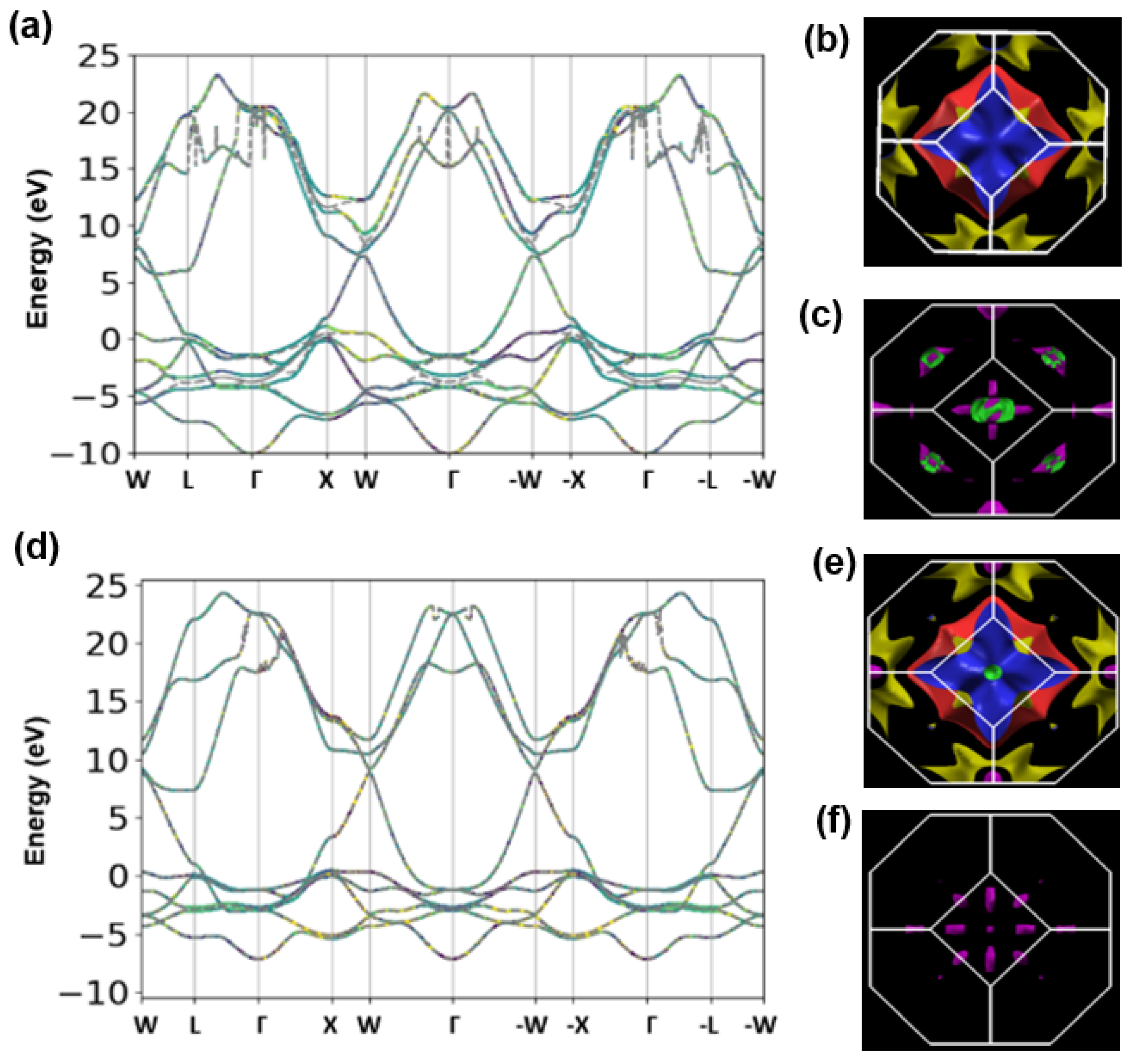

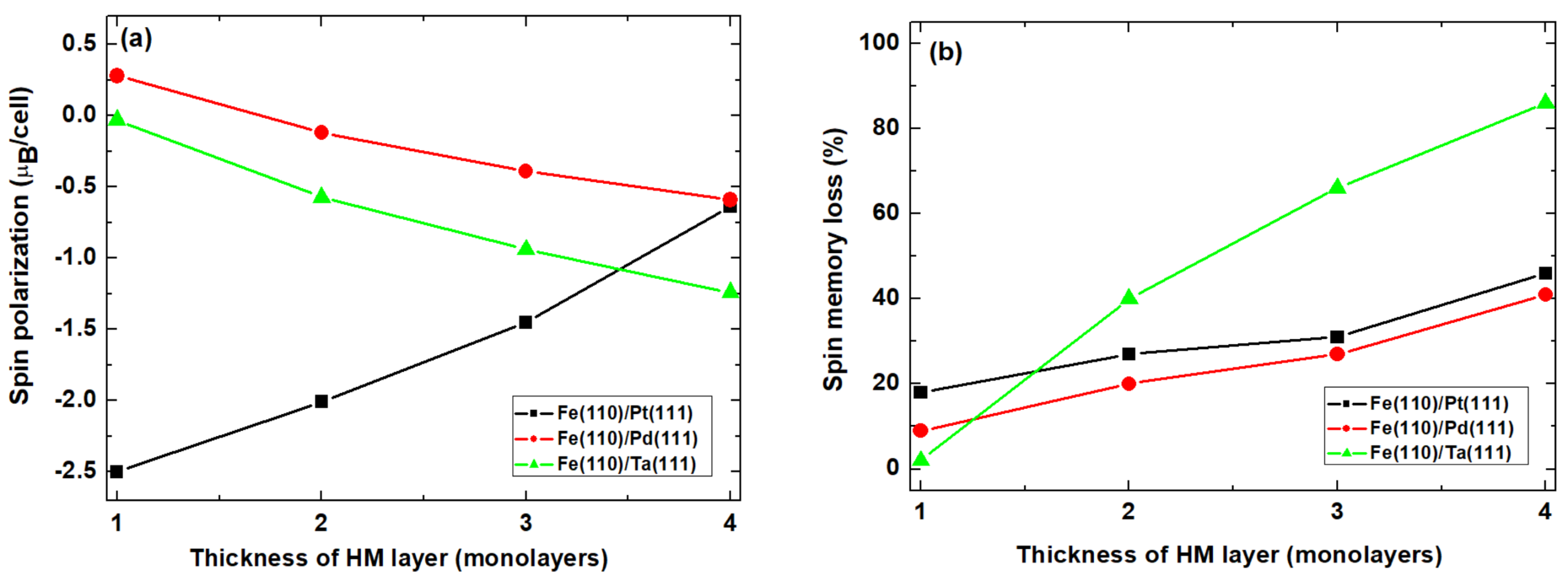
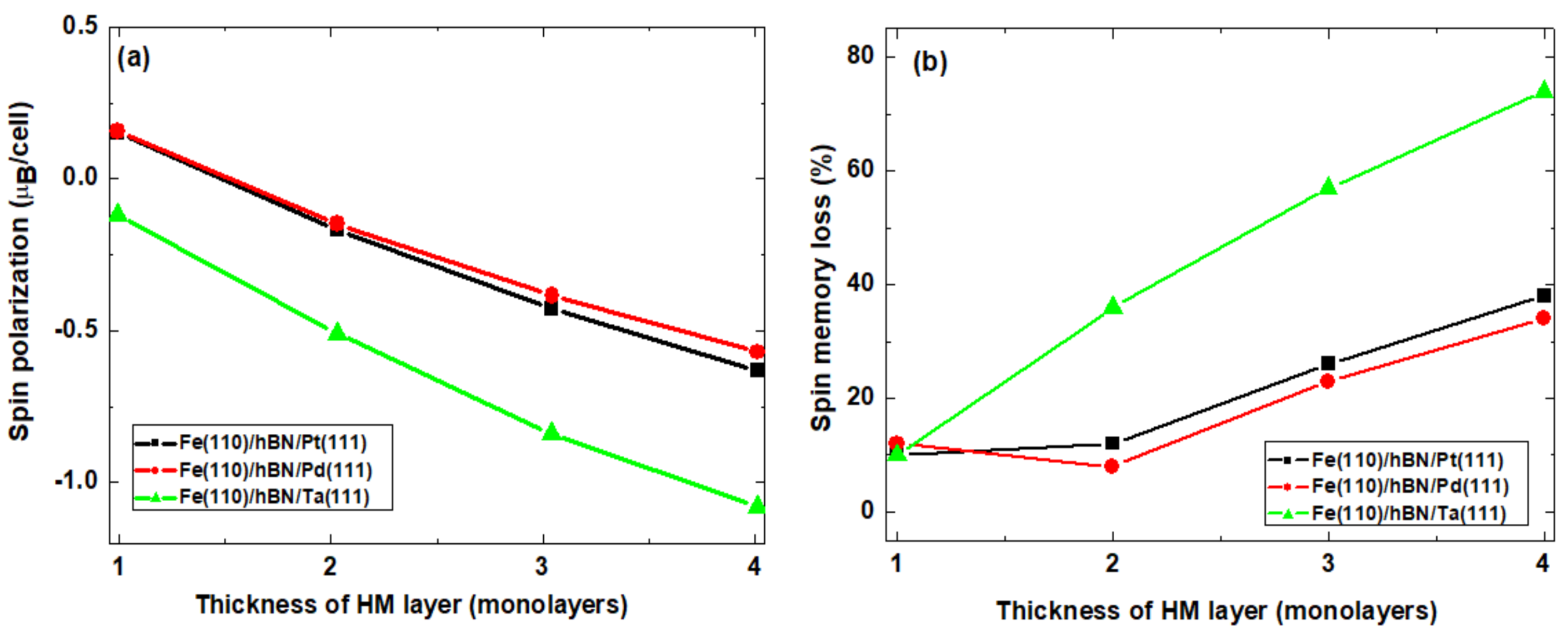

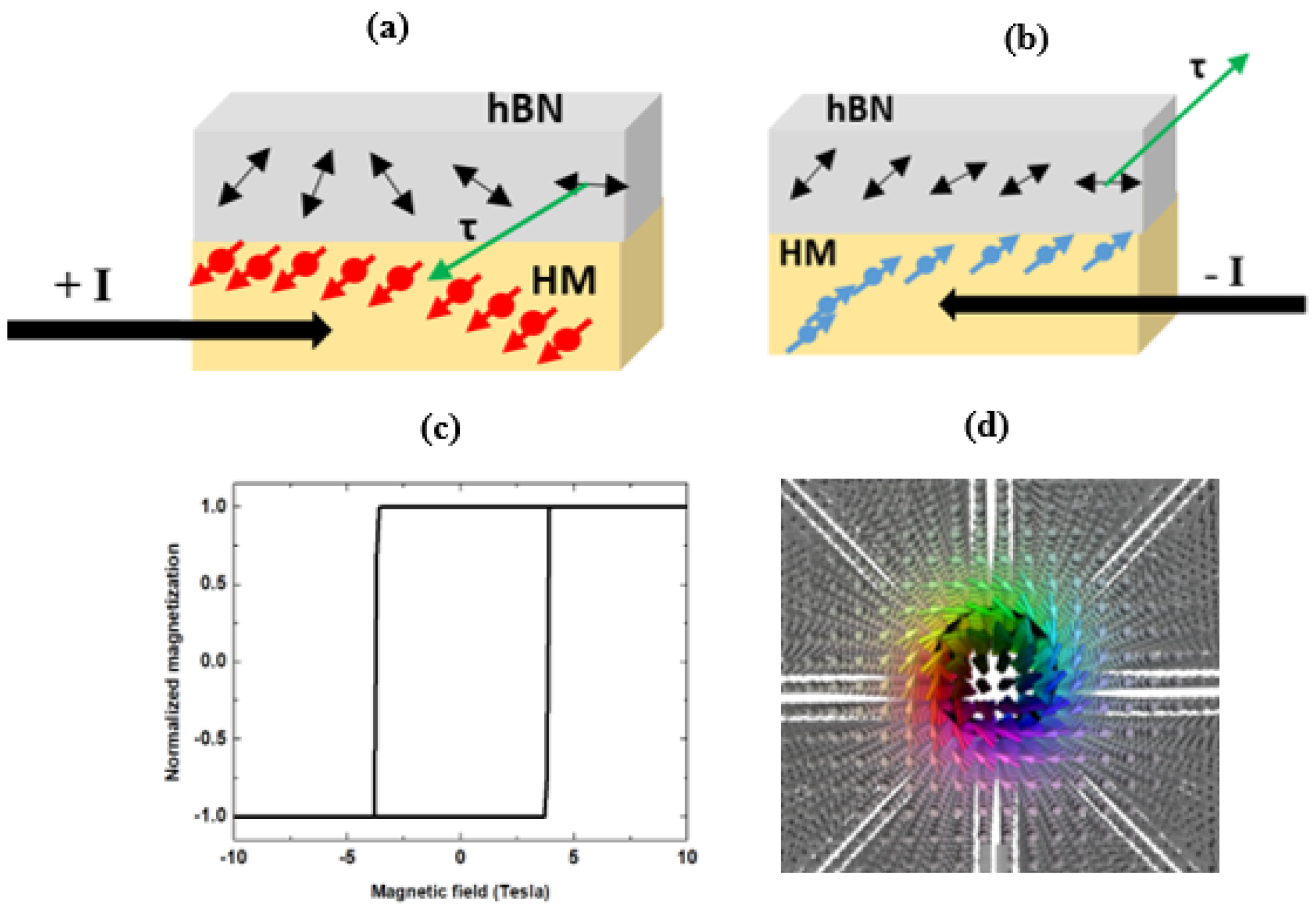

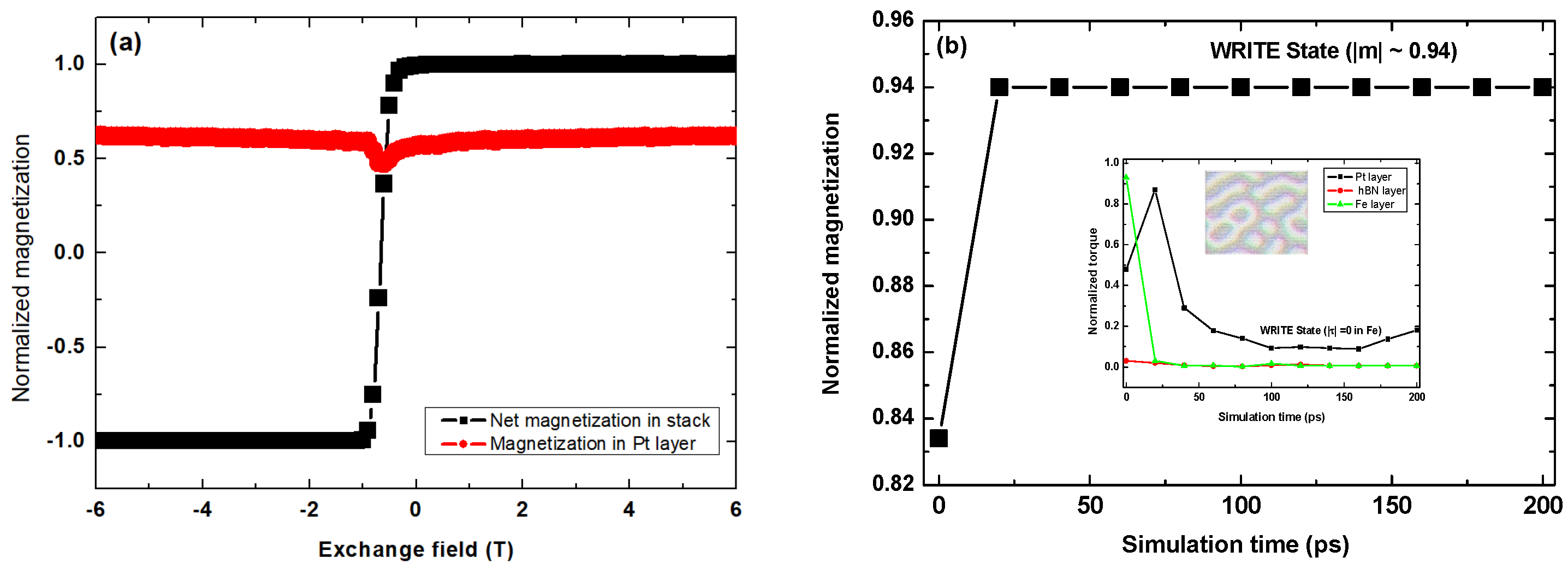
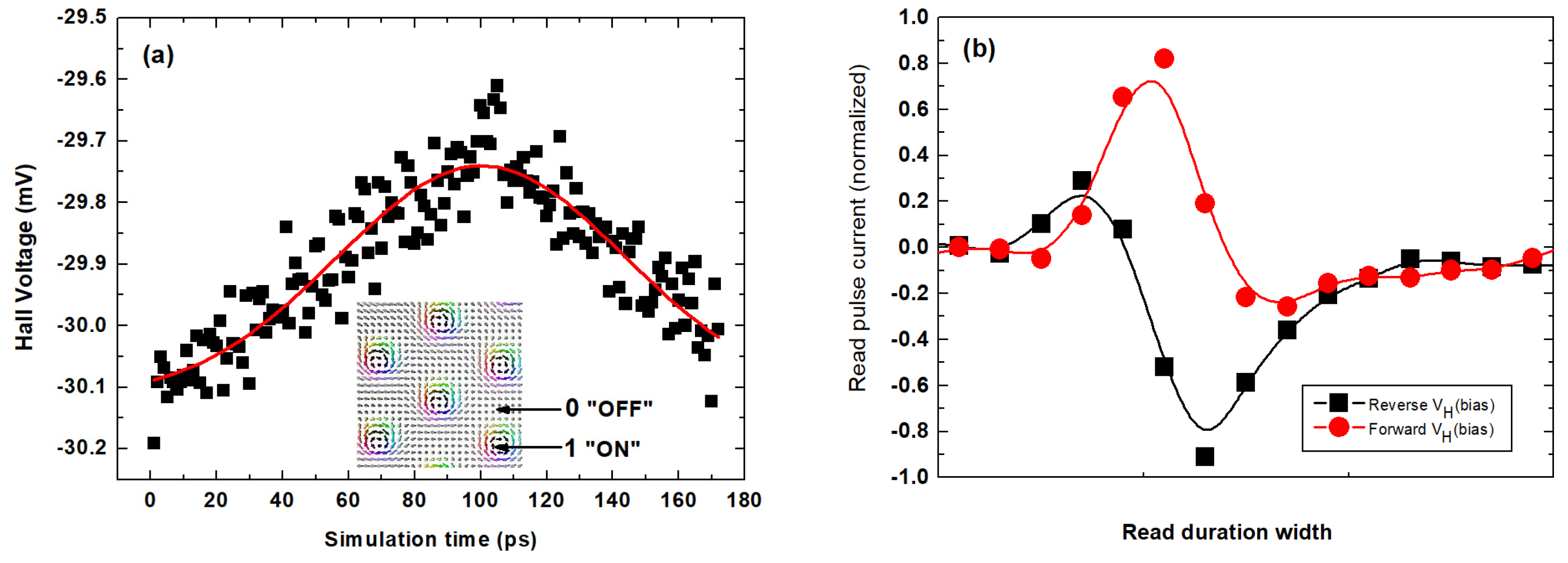
| System | αR (10−8 Jm) | g↑↓ (1019 m−2) | Ku (106 Jm3) | Jij (10−22 J) | Dij (10−22 J) |
|---|---|---|---|---|---|
| Fe(110)/hBN/Pt | 4.00 | 4.9 ± 0.5 [53] | 6.6 [54] | 28.4 | 0.61 |
| Fe(110)/hBN/Pd | 1.52 | 2.7 ± 0.4 [55] | 1.8 [54] | 10.9 | 0.28 |
| Fe(110)/hBN/Ta | 2.77 | 6.7 ± 0.4 [56,57] | 8.1 | 23.6 | 0.86 |
Publisher’s Note: MDPI stays neutral with regard to jurisdictional claims in published maps and institutional affiliations. |
© 2021 by the author. Licensee MDPI, Basel, Switzerland. This article is an open access article distributed under the terms and conditions of the Creative Commons Attribution (CC BY) license (https://creativecommons.org/licenses/by/4.0/).
Share and Cite
Ukpong, A.M. Emergence of Nontrivial Spin Textures in Frustrated Van Der Waals Ferromagnets. Nanomaterials 2021, 11, 1770. https://doi.org/10.3390/nano11071770
Ukpong AM. Emergence of Nontrivial Spin Textures in Frustrated Van Der Waals Ferromagnets. Nanomaterials. 2021; 11(7):1770. https://doi.org/10.3390/nano11071770
Chicago/Turabian StyleUkpong, Aniekan Magnus. 2021. "Emergence of Nontrivial Spin Textures in Frustrated Van Der Waals Ferromagnets" Nanomaterials 11, no. 7: 1770. https://doi.org/10.3390/nano11071770
APA StyleUkpong, A. M. (2021). Emergence of Nontrivial Spin Textures in Frustrated Van Der Waals Ferromagnets. Nanomaterials, 11(7), 1770. https://doi.org/10.3390/nano11071770






